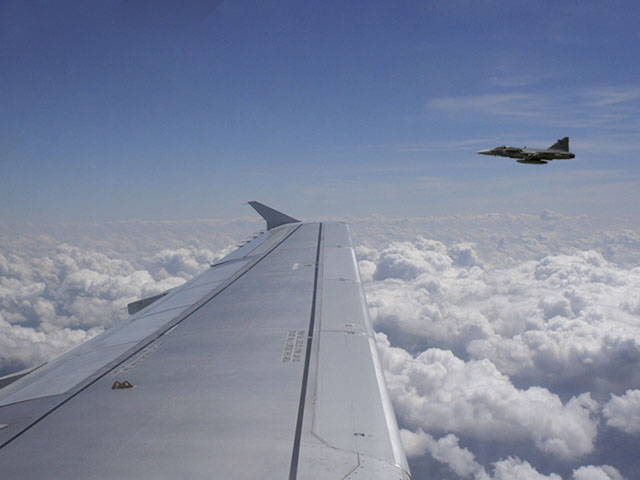2012-12-12 — /travelprnews.com/ — Nieuw Milligen, the Netherlands – An initial operational capability, comprising eleven military controller positions and two supervisory positions, has been established between the Royal Netherlands Air Force (RNLAF)’s Nieuw Milligen Air Operations Control Station (AOCS) and the Maastricht Upper Area Control Centre (MUAC)’s air traffic control system.
One RNLAF radar approach control sector and two arrival sectors (Woensdrecht and Gilze Rijen) have switched to the extension of the MUAC system.
For the first time, Dutch military controllers can use the data generated by the MUAC system(e.g. correlated aircraft tracks and flight plans) to control some of the densest and most complex airspace in the world. This entails MUAC processing information for approach and tower control alongside upper airspace operations.
This development is part of the Shared ATS System (SAS) project, a pioneering project of ATM data services provided by one air navigation service provider to the benefit of another one in the core area of Europe.
The project is governed by a Cooperation Agreement between the Ministry of Defence of the Netherlands and EUROCONTROL and is conducted in a true spirit of partnership.
Under the terms of the Agreement, MUAC makes the relevant correlated radar and flight plan data available to the RNLAF military ATC centre at AOCS Nieuw Milligen and seven RNLAF airbases. This is done by extending the operational MUAC air traffic control system, establishing a ‘virtual centre’ across the various RNLAF sites.
For MUAC and the RNLAF, using a shared picture brings certainty on a common view of the traffic. The primary benefit of the new arrangement is therefore greater safety brought by a closer understanding between military and civil controllers.
Where previously verbal coordination procedures ensured synchronisation of views, this is now automated, which also means an important reduction in workload for both supervisors and controllers at both sites.
The SAS project also provides important efficiency gains as civil controllers are aware of the status of the military areas and the intentions of the military aircraft operating in these areas, enabling more effective capacity management.
In terms of cost-efficiency, too, the benefits of the SAS are considerable. As MUAC facilities are upgraded and /or developed to SESAR (Single European Sky ATM Research) standards, the technical improvements will automatically flow to the RNLAF virtual military centre served from MUAC.
On 14 December 2012, a second radar approach control sector will connect to the SAS system. In the subsequent phase, the third radar approach control sector will use the SAS system in March 2013. Full operational capability is planned for October 2013, with RNLAF en-route, approach and tower control operations using the SAS system. The former RNLAF systems (PHAROS and AUTOTRAC) will then be decommissioned.
The implementation of such a virtual centre hosted within the operational system of another facility paves the way for further harmonisation in air traffic management. It is a de-facto solution for the defragmentation required in the Single European Sky.
For further information, contact:
MUAC
Mireille Roman, tel.: +31 43 366 1352
masuac.info@eurocontrol.int
Website: www.eurocontrol.int/muac
RNLAF
Directorate of Information and Communication, tel: +31 70 3188888
lucoinfo@mindef.nl
Website: www.luchtmacht.nl
Related Documents
- Press release pdf – 37.991 kB
NOTE TO EDITORS
The Maastricht Upper Area Control Centre (MUAC), operated by EUROCONTROL on behalf of four States, provides control for the upper airspace (above 24,500 feet, i.e. approximately 7,500 metres) of Belgium, Luxembourg, the Netherlands and north-west Germany. The lower airspace is managed by the national providers, Belgocontrol, Luchtverkeersleiding Nederland (LVNL) and Deutsche Flugsicherung (DFS) respectively. Since 1972, MUAC has embodied the political commitment entered into by Belgium, Germany, the Netherlands and Luxembourg to provide joint air traffic services. The international area of responsibility it covers is a perfect example of the simplification and harmonisation of airspace in Europe. MUAC is a model for cross-border projects in the spirit of the Single European Sky. More than 1.5 million flights pass through MUAC’s area of responsibility each year, making it the second busiest air traffic control facility in Europe in terms of traffic volume. During the summer, there are up to 5,200 flights per day. In order to facilitate the closest possible cooperation between civil and military air traffic, a Deutsche Flugsicherung (DFS) unit, controlling military operations over north-west Germany, is located on MUAC’s premises. Real-time radar and flight plan data is exchanged with the military aviation partners in Belgium and the Netherlands. To further improve safety, MUAC controller working positions will be deployed at the Netherlands’ military facilities as a virtual extension of the MUAC ATC system. For several years in a row MUAC’s high performance has been reported in the ATM Cost-Efficiency (ACE) Benchmarking Reports. Royal Netherlands Air Force / AOCS NM (Air Operations Control Station Nieuw Milligen) The military ATC and Air Defence tasks of the Royal Netherlands Air Force are carried out at the Air Operations Control Station at Nieuw Milligen. The ATC Centre of the RNLAF provides air traffic service for military flights to and from specific training areas. It also controls civil and military flights around several airbases in the Netherlands. In addition, an aeronautical service is provided to the RNLAF airbases and external parties. The RNLAF Air Defence Unit is part of the integrated NATO system and monitors and coordinates defences within Dutch airspace. One of its tasks is operational support for the Quick Reaction Alert (QRA) force. AOCS NM plays an active role in the dynamic (inter)national ATC and air defence community and priority is given to flexibility and cooperation with civil partners.
###

